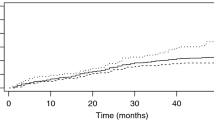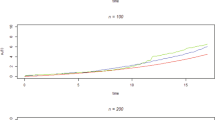Abstract
During their follow-up, patients with cancer can experience several types of recurrent events and can also die. Over the last decades, several joint models have been proposed to deal with recurrent events with dependent terminal event. Most of them require the proportional hazard assumption. In the case of long follow-up, this assumption could be violated. We propose a joint frailty model for two types of recurrent events and a dependent terminal event to account for potential dependencies between events with potentially time-varying coefficients. For that, regression splines are used to model the time-varying coefficients. Baseline hazard functions (BHF) are estimated with piecewise constant functions or with cubic M-Splines functions. The maximum likelihood estimation method provides parameter estimates. Likelihood ratio tests are performed to test the time dependency and the statistical association of the covariates. This model was driven by breast cancer data where the maximum follow-up was close to 20 years.





Similar content being viewed by others
References
Abrahamowicz M, MacKenzie T (2007) Joint estimation of time-dependent and non-linear effects of continuous covariates on survival. Stat Med 26(2):392–408
Abrahamowicz M, Mackenzie T, Esdaile JM (1996) Time-dependent hazard ratio: modeling and hypothesis testing with application in lupus nephritis. J Am Stat Assoc 91(436):1432–1439
Bellera C, MacGrogan G, Debled M, de Lara T, Brouste V, Mathoulin-Pelissier S (2010) Variables with time-varying effects and the Cox model: some statistical concepts illustrated with a prognostic factor study in breast cancer. BMC Med Res Methodol 10(1):20
Cai J, Schaubel D (2004) Marginal means/rates models for multiple type recurrent event data. Lifetime Data Anal 10(2):121–138
Cai Z, Sun Y (2003) Local linear estimation for time-dependent coefficients in Cox’s regression models. Scand J Stat 30(1):93–111
Chiang C, Wang M (2009) Varying-coefficient model for the occurrence rate function of recurrent events. Ann Inst Stat Math 61(1):197–213
Commenges D, Rondeau V (2000) Standardized martingale residuals applied to grouped left truncated observations of dementia cases. Lifetime Data Anal 6(3):229–235
Cook RJ, Lawless JF (1997) Marginal analysis of recurrent events and a terminating event. Stat Med 16:911–924
De Boor C (2001) A practical guide to splines, vol 27. Springer, Berlin
Duchateau L, Janssen P, Kezic I, Fortpied C (2003) Evolution of recurrent asthma event rate over time in frailty models. J Royal Stat Soc 52(3):355–363
Elkhuizen P, van de Vijver M, Hermans J, Zonderland H, van de Velde C, Leer J (1998) Local recurrence after breast-conserving therapy for invasive breast cancer: high incidence in young patients and association with poor survival. Int J Radiat Oncol Biol Phys 40(4):859–867
Fan J, Gijbels I, King M (1997) Local likelihood and local partial likelihood in hazard regression. Ann Stat 25(4):1661–1690
Ghosh D, Lin D (2000) Nonparametric analysis of recurrent events and death. Biometrics 56(2):554–562
Ghosh D, Lin D (2002) Marginal regression models for recurrent and terminal events. Stat Sinica 12(3):663–688
Hastie T, Tibshirani R (1993) Varying-coefficient models. J Royal Stat Soc 55(4):757–796
Huang C, Wang M (2004) Joint modeling and estimation for recurrent event processes and failure time data. J Am Stat Assoc 99(468):1153–1165
Huang X, Liu L (2007) A joint frailty model for survival and gap times between recurrent events. Biometrics 63(2):389–397
Jemal A, Bray F, Center M, Ferlay J, Ward E, Forman D (2011) Global cancer statistics. CA 61:69–90
Kauermann G, Krivobokova T, Fahrmeir L (2009) Some asymptotic results on generalized penalized spline smoothing. J Royal Stat Soc 71(2):487–503
Li Q, Lagakos S (1997) Use of Wei–Lin–Weissfeld method for the analysis of a recurring and a terminating event. Stat Med 16:925–940
Lin D, Wei L, Yang I, Ying Z (2000) Semiparametric regression for the mean and rate functions of recurrent events. J Royal Stat Soc 62(4):711–730
Liu L, Wolfe R, Huang X (2004) Shared frailty models for recurrent events and a terminal event. Biometrics 60(3):747–756
Marquardt D (1963) An algorithm for least-squares estimation of nonlinear parameters. J Soc Ind Appl Math 11(2):431–441
Martinussen T, Scheike T, Skovgaard I (2002) Efficient estimation of fixed and time-varying covariate effects in multiplicative intensity models. Scand J Stat 29(1):57–74
Mazroui Y, Mathoulin-Pelissier S, Soubeyran P, Rondeau V (2012) General joint frailty model for recurrent event data with a dependent terminal event: application to follicular lymphoma data. Stat Med 31:1162–1176
Montagna E, Bagnardi V, Rotmensz N, Viale G, Renne G, Cancello G et al (2012) Breast cancer subtypes and outcome after local and regional relapse. Ann Onc 23(2):324–331
Monteiro Grillo I, Jorge M, Marques Vidal P, Ortiz M, Ravasco P (2005) The effect of locoregional recurrence on survival and distant metastasis after conservative treatment for invasive breast carcinoma. Clin Oncol 17(2):111–117
O’Shaughnessy J (2005) Extending survival with chemotherapy in metastatic breast cancer. Oncologist 10(3):20–29
Putter H, Sasako M, Hartgrink H, Van de Velde C, Van Houwelingen J (2005) Long-term survival with non-proportional hazards: results from the dutch gastric cancer trial. Stat Med 24(18):2807–2821
Rondeau V, Mathoulin-Pelissier S, Jacqmin-Gadda H, Brouste V, Soubeyran P (2007) Joint frailty models for recurring events and death using maximum penalized likelihood estimation: application on cancer events. Biostatistics 8(4):708–721
Rondeau V, Mazroui Y, Gonzalez JR (2012) frailtypack: an R package for the analysis of correlated survival data with frailty models using penalized likelihood estimation or parametrical estimation. J Stat Softw 47(4):1–28
Schaubel D, Zhang M (2010) Estimating treatment effects on the marginal recurrent event mean in the presence of a terminating event. Lifetime Data Anal 16(4):451–477
Spiekerman C, Lin D (1998) Marginal regression models for multivariate failure time data. J Am Stat Assoc 93(443):1164–1175
Wang M, Qin J, Chiang C (2001) Analyzing recurrent event data with informative censoring. J Am Stat Assoc 96(455):1057–1065
Ye Y, Kalbeisch J, Schaubel D (2007) Semiparametric analysis of correlated recurrent and terminal events. Biometrics 63(1):78–87
Yu Z, Lin X (2008) Nonparametric regression using local kernel estimating equations for correlated failure time data. Biometrika 95(1):123–137
Yu Z, Lin X (2010) Semiparametric regression with time-dependent coefficients for failure time data analysis. Stat Sinica 20:853–869
Yu Z, Liu L, Bravata D, Williams L, Tepper R (2012) A semiparametric recurrent events model with time-varying coefficients. Stat Med 32(6):1016–1026
Zeng D, Cai J (2010) A semiparametric additive rate model for recurrent events with an informative terminal event. Biometrika 97(3):699–712
Zeng D, Lin D (2009) Semiparametric transformation models with random effects for joint analysis of recurrent and terminal events. Biometrics 65(3):746–752
Zhu L, Sun J, Tong X, Srivastava D (2010) Regression analysis of multivariate recurrent event data with a dependent terminal event. Lifetime Data Anal 16(4):478–490
Conflict of interest
None declared.
Author information
Authors and Affiliations
Corresponding author
Appendices
Appendix 1: Log-likelihood calculus
The conditional likelihood can be written as:
\(Pevent_i^{(l)}\) represents the contribution to the likelihood of the recurrent event \(l\), and \(Pdeath_i\) the contribution to the likelihood of death for the individual \(i\):
The conditional individual contribution to the likelihood is:
Then, we integrate \(L_i(\varPhi |u_i,v_i)\) through the random effects \(u_i,v_i\) to obtain the likelihood.
Appendix 2: Estimation of the individual random effects \(u_i,v_i\) for the martingale residuals
Let \(T_i=\{T_{ij}^{(l)}, j=1,\ldots ,n_i^{(l)+1}\}\). The posterior probability density function is
and
Here \(f(T_i|u_i,v_i,\widehat{\varPhi })\) corresponds to the likelihood of the individual \(i\) given \(\widehat{\varPhi }\) and given the random effects \(u_i,v_i\).
The mode of the posterior probability density function is obtained by maximizing it using the Marquardt algorithm:
where,
Rights and permissions
About this article
Cite this article
Mazroui, Y., Mauguen, A., Mathoulin-Pélissier, S. et al. Time-varying coefficients in a multivariate frailty model: Application to breast cancer recurrences of several types and death. Lifetime Data Anal 22, 191–215 (2016). https://doi.org/10.1007/s10985-015-9327-y
Received:
Accepted:
Published:
Issue Date:
DOI: https://doi.org/10.1007/s10985-015-9327-y




